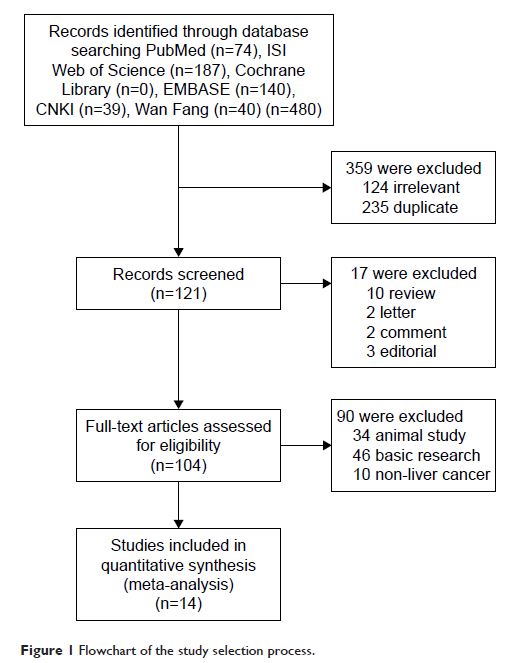108384
论文已发表
注册即可获取德孚的最新动态
IF 收录期刊
- 3.4 Breast Cancer (Dove Med Press)
- 3.2 Clin Epidemiol
- 2.6 Cancer Manag Res
- 2.9 Infect Drug Resist
- 3.7 Clin Interv Aging
- 5.1 Drug Des Dev Ther
- 3.1 Int J Chronic Obstr
- 6.6 Int J Nanomed
- 2.6 Int J Women's Health
- 2.9 Neuropsych Dis Treat
- 2.8 OncoTargets Ther
- 2.0 Patient Prefer Adher
- 2.2 Ther Clin Risk Manag
- 2.5 J Pain Res
- 3.0 Diabet Metab Synd Ob
- 3.2 Psychol Res Behav Ma
- 3.4 Nat Sci Sleep
- 1.8 Pharmgenomics Pers Med
- 2.0 Risk Manag Healthc Policy
- 4.1 J Inflamm Res
- 2.0 Int J Gen Med
- 3.4 J Hepatocell Carcinoma
- 3.0 J Asthma Allergy
- 2.2 Clin Cosmet Investig Dermatol
- 2.4 J Multidiscip Healthc

FoxM1 在肝细胞癌中的临床病理学和预后意义:一项综合分析
Authors Liang C, Zhao J, Ge H, Li G, Wu J
Received 30 October 2017
Accepted for publication 13 April 2018
Published 19 June 2018 Volume 2018:11 Pages 3561—3571
DOI https://doi.org/10.2147/OTT.S155541
Checked for plagiarism Yes
Review by Single-blind
Peer reviewers approved by Dr Cristina Weinberg
Peer reviewer comments 2
Editor who approved publication: Dr Faris Farassati
Background and aims: Recently, the abnormal expression of FoxM1 has been found in many
malignant tumors. However, the clinicopathological and prognostic value of
FoxM1 expression in hepatocellular carcinoma (HCC) patients remains
controversial. We conducted a meta-analysis to establish the relationship
between FoxM1 expression and the clinicopathological features and prognostic
value in patients with HCC.
Methods: An electronic search for relevant articles was conducted according
to a set of criteria in the PubMed, Cochrane Library, Web of Science, EMBASE,
Chinese CNKI and Chinese WanFang databases. The correlation data between FoxM1
expression and clinicopathological features and survival outcomes were
analyzed. Pooled odds ratios (ORs) and hazard ratios (HRs) with 95% CIs were
calculated using STATA14.2.
Results: A total of 14 studies comprising of 2,036 patients were enrolled
in this meta-analysis. The results showed that FoxM1 expression was related to
the incidence, tumor size (>5 cm), vascular invasion, differentiation and
TNM stage. Moreover, overexpression of FoxM1 indicated a poor 3- and 5-year
overall survival rate (OS) and recurrence-free survival rate (disease-free
survival rate).
Conclusion: Our meta-analysis indicated that FoxM1 expression was associated
with incidence, tumor size (>5 cm), vascular invasion, differentiation and
TNM stage. Accordingly, FoxM1 may be a reliable prognostic biomarker for
patients with HCC. However, additional high-quality studies are still needed to
further support these findings.
Keywords: FoxM1, hepatocellular carcinoma, clinicopathological feature,
prognosis, meta-analysis
